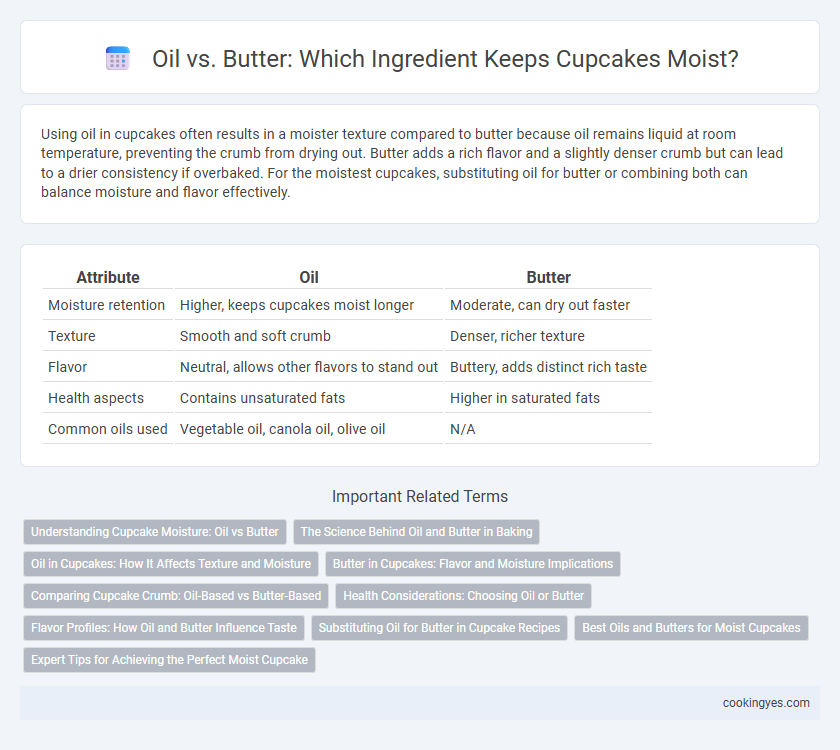Using oil in cupcakes often results in a moister texture compared to butter because oil remains liquid at room temperature, preventing the crumb from drying out. Butter adds a rich flavor and a slightly denser crumb but can lead to a drier consistency if overbaked. For the moistest cupcakes, substituting oil for butter or combining both can balance moisture and flavor effectively.
Table of Comparison
| Attribute | Oil | Butter |
|---|---|---|
| Moisture retention | Higher, keeps cupcakes moist longer | Moderate, can dry out faster |
| Texture | Smooth and soft crumb | Denser, richer texture |
| Flavor | Neutral, allows other flavors to stand out | Buttery, adds distinct rich taste |
| Health aspects | Contains unsaturated fats | Higher in saturated fats |
| Common oils used | Vegetable oil, canola oil, olive oil | N/A |
Understanding Cupcake Moisture: Oil vs Butter
Oil-based cupcakes retain more moisture due to oil's liquid state at room temperature, resulting in a tender and soft crumb. Butter adds rich flavor but solidifies when cooled, which can make cupcakes slightly denser and less moist. Choosing oil enhances moisture retention, while butter contributes flavor complexity and structure in cupcake recipes.
The Science Behind Oil and Butter in Baking
Oil contributes to cupcake moisture by remaining liquid at room temperature, which helps cakes stay tender and moist longer. Butter contains milk solids and water, which evaporate during baking, creating a slightly drier texture but richer flavor. The choice between oil and butter affects crumb structure and mouthfeel, with oil producing softer crumbs due to its 100% fat content compared to butter's 80%.
Oil in Cupcakes: How It Affects Texture and Moisture
Oil in cupcakes enhances moisture retention by coating flour proteins, which limits gluten formation and results in a softer, more tender crumb. Unlike butter, oil remains liquid at room temperature, contributing to a consistently moist texture that lasts longer. This characteristic makes oil especially effective for baking cupcakes that stay fresh and moist over several days.
Butter in Cupcakes: Flavor and Moisture Implications
Butter enhances cupcake flavor by adding a rich, creamy taste that oil cannot replicate, contributing to a more indulgent texture. Its solid fat structure traps air during creaming, promoting a tender crumb while maintaining moisture. The natural water content in butter also helps steam during baking, resulting in a moist, flavorful cupcake with a golden crust.
Comparing Cupcake Crumb: Oil-Based vs Butter-Based
Oil-based cupcakes yield a moister and denser crumb due to oil's liquid state at room temperature, which coats flour proteins and inhibits gluten formation. Butter-based cupcakes produce a lighter, airier crumb with a richer flavor but tend to dry out faster because butter solidifies when cool. Choosing oil results in consistent moisture retention, while butter offers a tender texture and enhanced taste.
Health Considerations: Choosing Oil or Butter
Oil generally provides a moister texture in cupcakes due to its liquid state at room temperature, while butter offers a richer flavor and slightly denser crumb. Health-wise, using oil such as olive or avocado oil can introduce healthier monounsaturated fats and reduce saturated fat intake compared to butter, which contains higher levels of saturated fat and cholesterol. Opting for oil may benefit heart health, but butter provides essential fat-soluble vitamins like A and D, making the choice dependent on dietary priorities.
Flavor Profiles: How Oil and Butter Influence Taste
Oil imparts a neutral, light texture to cupcakes, allowing other flavors like vanilla or cocoa to shine without interference. Butter contributes a rich, creamy taste with a slightly caramelized undertone that deepens the overall flavor profile. Choosing butter enhances complexity and traditional flavor, while oil keeps the taste more straightforward and moist.
Substituting Oil for Butter in Cupcake Recipes
Substituting oil for butter in cupcake recipes increases moisture retention due to oil's liquid state at room temperature, resulting in a softer crumb. While butter adds richness and a distinct flavor from its milk solids, oil provides a neutral taste that allows other ingredients to shine. For best texture, use vegetable or canola oil at a 1:1 ratio in place of melted butter when aiming for extra moist cupcakes.
Best Oils and Butters for Moist Cupcakes
Using oils such as vegetable oil, canola oil, or light olive oil enhances cupcake moisture due to their liquid state at room temperature, resulting in a tender crumb. Butter contributes rich flavor and structure but can sometimes yield a drier texture if overbaked, making unsalted European-style butter ideal for balancing taste and moisture. Combining melted butter with oil or incorporating ingredients like sour cream or yogurt can optimize moisture retention while delivering a flavorful cupcake.
Expert Tips for Achieving the Perfect Moist Cupcake
Using oil instead of butter in cupcake recipes ensures a consistently moist texture because oil remains liquid at room temperature, preventing dryness. Expert bakers recommend substituting oil for butter when aiming for softness, especially in vanilla or chocolate cupcakes. For enhanced flavor without sacrificing moisture, some suggest blending melted butter with oil to achieve a rich yet tender crumb.
Oil vs Butter for Cupcake Moisture Infographic

 cookingyes.com
cookingyes.com